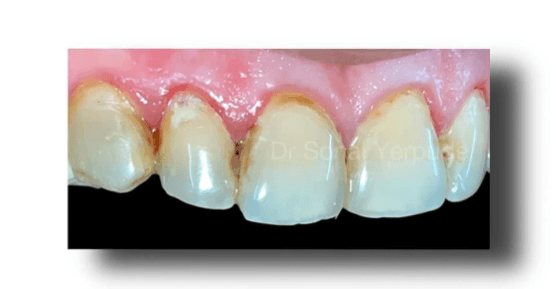Dr Sonal Yerpude is the winner at 2nd position, jury special mention for DR Pronto Esthetic Challenge 1, 2021-2022
Introduction
Class V composite restorations are placed every day in the restorative dental practice. Whether the cause is dental caries or abfraction, this area of the tooth can be deceptively difficult to restore in a predictable fashion. Etiology behind the Class V caries is the key element in long term prognosis of the restorative procedure. In this case report, I have discussed a case of multiple carious lesions and the restorative procedure followed.
Case Report
A 45-year old lady working in a multi-national company, walked into the clinic with chief complaint of sensitive and discoloured anterior teeth which made her self-conscious. Thorough clinical examination revealed multiple Class V and Class III carious lesions on teeth #11 #12 #13 #21 #22 #23. (Fig.1) Patient had limited time with her. After discussing and considering all the parameters with radiographic and clinical examination, caries excavation and rehabilitation with composite restorations was planned. Bioactive and highly esthetic Activa™ Pronto was the obvious material of choice, followed by finishing and polishing.

Restorative Procedure
The caries excavation and restorative procedure was carried out in a single appointment. Isolation is the key to success for any restorative procedure and due to the current infectious situation following the pandemic, application of rubber dam and achieving a functional isolation had become the standard protocol for all routine dental procedures. For this case we had achieved isolation using medium thickness rubber dam sheets. (Fig.2)

After the usual preliminary procedure, a round diamond bur was used to eliminate the entire enamel and dentin defect with bevelled margins. The bevel on the enamel portion of the preparation was increased to extend to the middle third of the tooth, so that the amount of micromechanical retention to enamel was maximized. This minimises the effects of flexural stress on the restoration and allows the composite material to blend better and esthetically with the natural tooth surface, eliminating the typical “kidney bean” appearance of most Class V composite restorations. The tooth was prepared by etching enamel and priming dentin. Next step was use of universal bonding agent followed by light curing. (Fig.3, 4)


The composite restoration was placed, using Activa™ Pronto composite material. (Fig.5)

Abrasive discs (Super-Snap Polishers) were used to contour the composite after final light curing had been done. (Fig.6,7)


A one-week follow-up (facial view) of the completed Class V restoration in the abfraction lesion. It was a joy to note the absence of “white line” at the cervical margin and how well the composite seamlessly blended into the tooth structure. (Fig.8)


Discussion
Tooth preparation, as demonstrated and described in this case report article, can create not only a better patient experience, but give the dentist an efficient and predictable way to minimally prepare teeth, excavate decay, finish, and polish composite resin restorative materials. Placing restorative materials in the Class V area can be challenging due to occlusal stresses, tooth flexure, and acid attack at the gingival margin from plaque retention.
A successful Class V composite filling must meet multiple criteria, including
- adequate polymerization
- the use of appropriate composition of resin material in an appropriate location of the cavity being restored
- bond strength at the tooth or cavity interface and
- proper isolation from oral fluids during restoration.
The combination of comfortable preparation, auxiliary retention, then placement of composite such as Activa™ Pronto that will help protect the gingival marginal seal, is an excellent approach to handling Class V composites in restorative practice.
The delivery of quality resin restorations is a bit challenging in cervical lesions. Activa™ Pronto was the best choice of light cure composite material in this case because it is:
- universal
- stackable and shapeable
- strong and durable
- wear and fracture resistant
- releases and recharges calcium, phosphate and fluoride.
Conclusions
The objective behind this case report is to emphasise the importance of good functional seal to the gingival aspect of the margin that would also be protected with ion exchange and acid resistance, giving this restoration the best chance for long-term success of Class V restorations in our routine dental practice.




















Comments